Culinary knives are probably the most important tool in the kitchen. If you’re not a pro in knives, you might think they are all the same.
You might also think that all that matters is how sharp they are. In reality, there are different types of kitchen knives designed for cutting different materials. And to get professional results, you need to choose wisely.
Understanding how knives work, their design and the function each part serves in your kitchen will help you in selecting the perfect knife. So, in this article, we have listed the different parts of a kitchen knife, its functions, and some tips on choosing the best one for you.
See the following picture for common parts of a kitchen knife, we will discuss each of them in details:
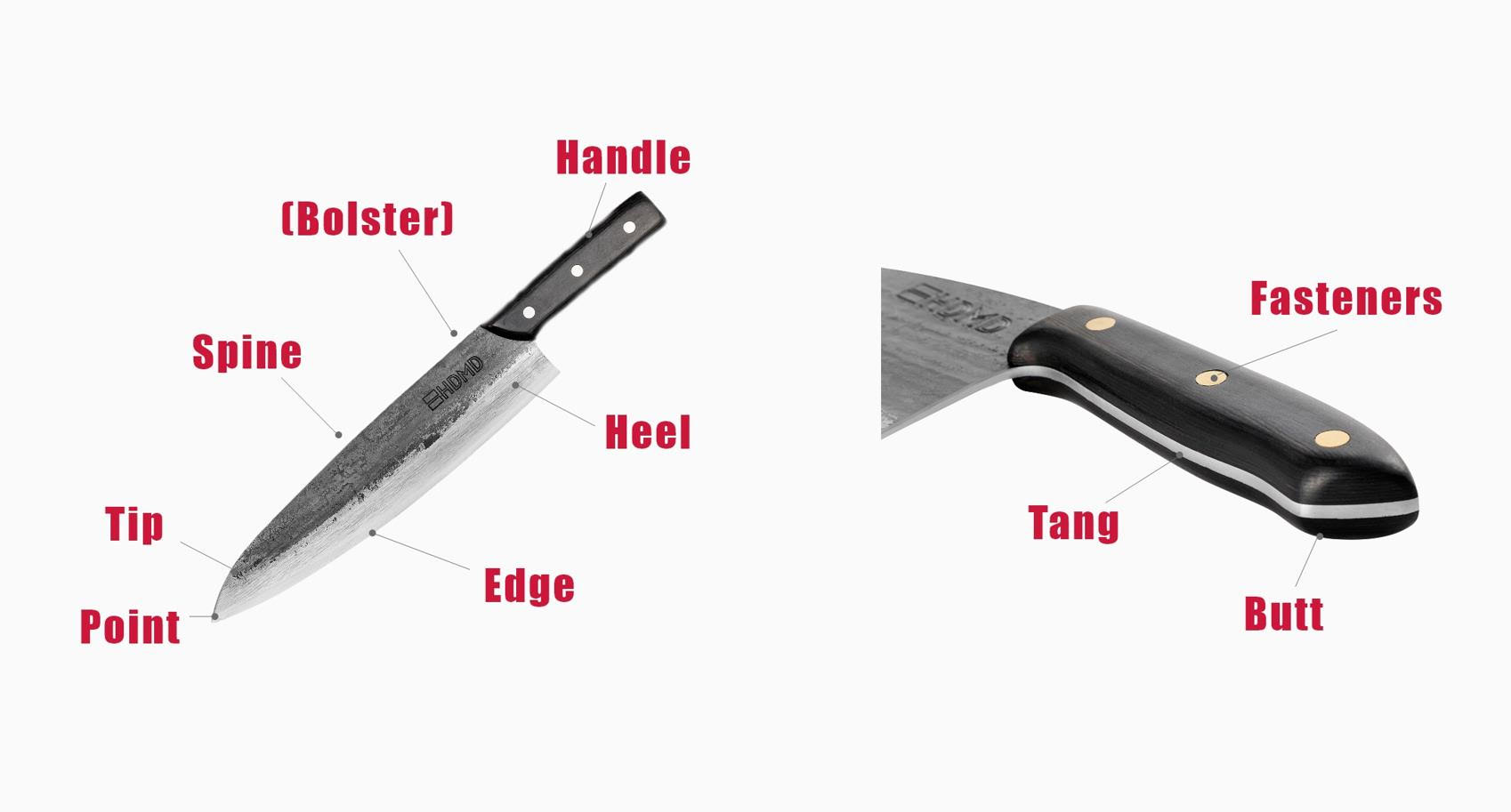
Table of contents
Knife point
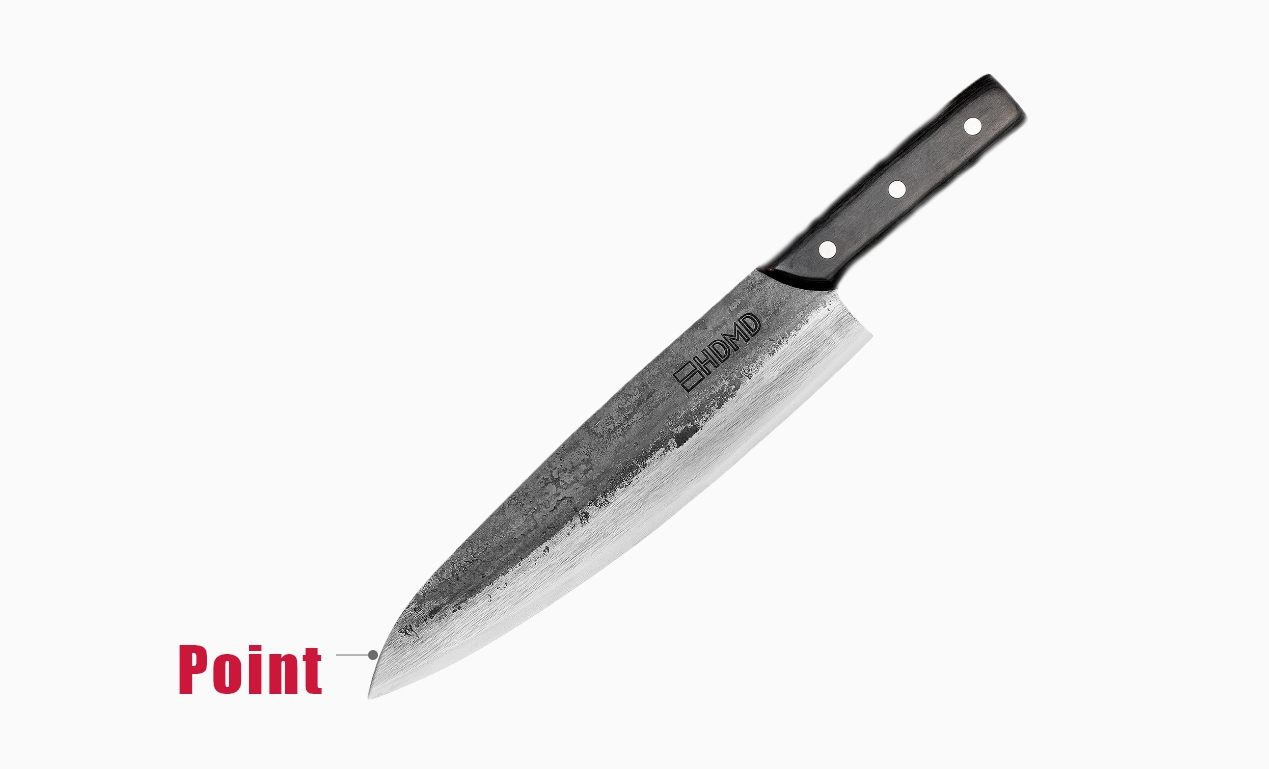
A kitchen knife’s point is the sharp, pointy end of the blade where the top and the bottom edges meet. It is usually used for piercing. You can also use your knife’s point for detailed cutting or decorative carving.
Some knives, on the other hand, have flat ground edges. This means that the point is all the way down to the edge. Santoku knives are a good example of this.
Knife tip
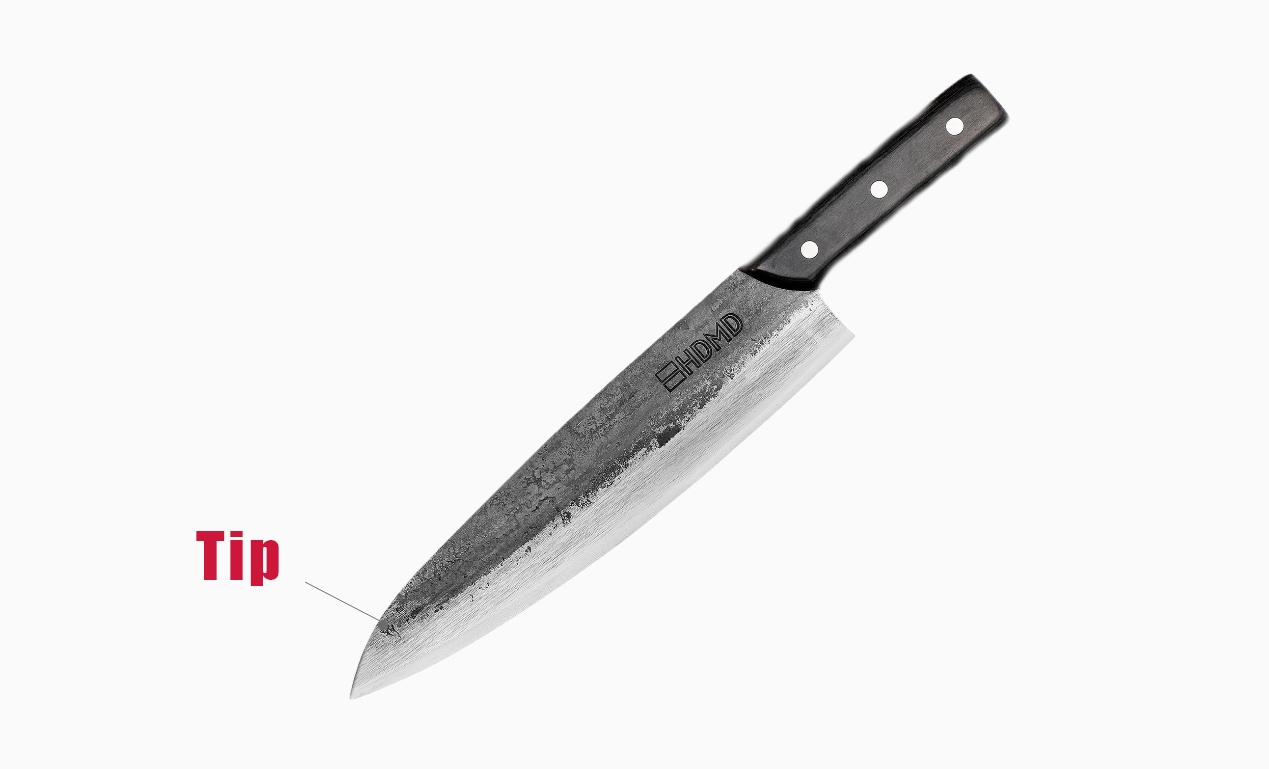
The tip is the smallest part of your knife’s blade and is closest to the tip. It is usually used for detailed and delicate cuts. The tip of your knife can be curved, flat, or pointed.
Knife spine
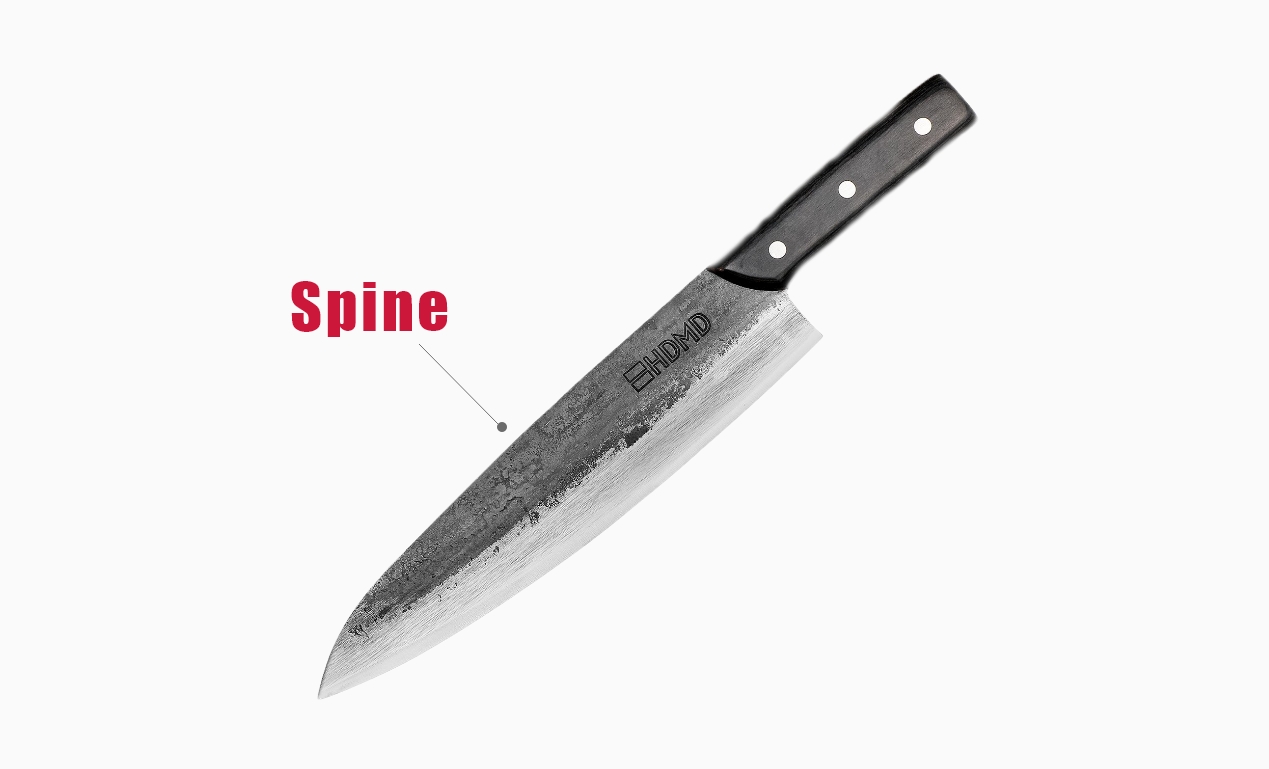
The spine is the unsharpened part of the blade that is opposite to the cutting edge. The thickness of this part usually determines the durability of the knife and where it is best used for. The spine’s thickness also affects the balance of the knives.
Thicker spines make stronger blades. Heavier blades are more suited for chopping chunkier ingredients such as thick meat cuts, bones, and other heavy food. Knives with thinner spines such as fillet knives, on the other hand, are more suited for thin cuts. These knives have their weights focused on the handle and are not suited for chopping.
The spine sometimes has a textured part near the handle to place the thumb of the user for extra control, which is called jimping.
Cutting edge
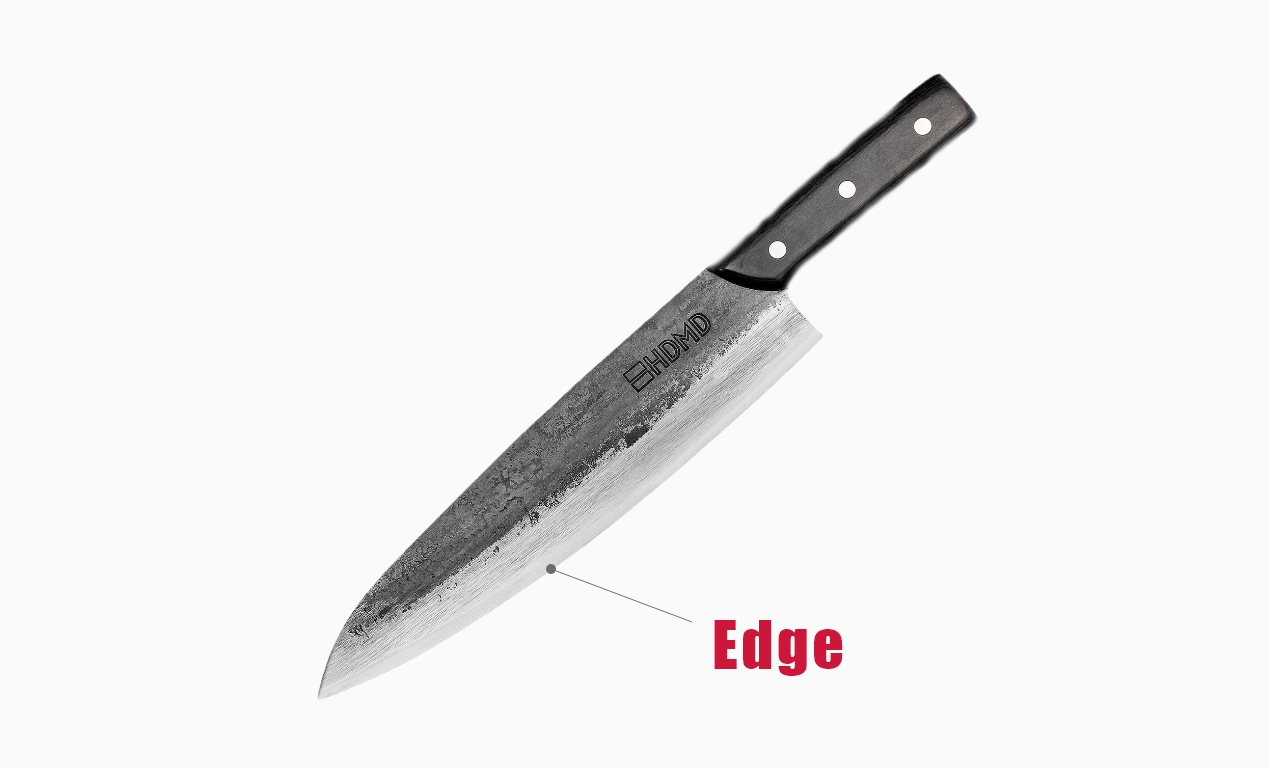
The cutting edge is the sharpened part of your knife’s blade. It is the part you cut with, going from the point of the blade to its heel. Different edges are used for different purposes.
The sharpness of your knife is determined by a method called grinding. For example, a finely ground edge makes a sharper knife. How sharp your knife is will also depend on the quality of the knife itself and how often you will sharpen it.
Many consider it as the most important part of a knife since it makes direct contact with the ingredients. To understand a knife’s edge, we’ll talk about what is a knife bevel, and the different grinding methods:
Bevel
A kitchen knife bevel is a surface that has been sharpened to form the knife’s edge. If you look closer, you will see a slight incline on one or both sides of the blade that leads to the edge. The following are the two types of bevel:
- Single bevel. A single bevel edge tapers on only one side of the blade. This means that the other side of the blade is either flat or concave. This kind of bevel is often used to make Japanese knives. A single bevel results in a sharper edge that fits the delicate cutting needs for Japanese cuisine.
- Double bevel. A double bevel edge tapers on both sides of the blade. Knives with double bevels are usually more durable.
What Is a Single Bevel Knife: The Ultimate Guide
Grinds
Knife edges come in different grinds that help them perform specialized functions. You may already be familiar with V-Edge knives since most chef knives come with this design. Here are the other styles of kitchen knife grinds:
- V-Edge. V-Edge is the most common knife edge. It is formed when two sides of the blade are ground into the shape of a V.
- Convex Edge. The Convex edge is formed when the two sides of the blade curve toward each other, making a curved V shape. To further visualize the shape, you can imagine it as the cross-section of an airplane wing. Due to its shape, it is stronger than the V-Edge. It is harder to maintain, though, as it is prone to turn into a standard V-Edge if you carelessly sharpen your knife.
- Hollow Ground. Hollow ground-edged knives usually have sharp and fine edges that have air pockets grounding to their sides. This creates less friction, allowing thinner slices without much food sticking on the knife. Hollow ground edges are not suitable for heavy chopping. Boning knives, filet knives, and chef knives usually have a hollow ground edge.
- Chisel. Chisel edges are very thin and are great for clean cuts. Filleting knives and chef’s knives usually have this cutting edge. The cross-section of a chisel edged-knife has one side slanted towards the point. The other side of the knife remains flat. Knives with a chisel edge are usually fragile despite being very sharp.
Different Types of Knife Grinds and Their Features
Granton edge
The rounded small air pockets you may find in some knives are called the Granton edge. These unique scallops are created to prevent food from sticking to the blade. The deign was first invented by the Granton company for their chef’s knives, and was soon adapted by various knife manufactures. You’ll see many Japanese Santoku sold with Granton edge design in today’s knife market.
What Is Granton Edge?
Knife heel
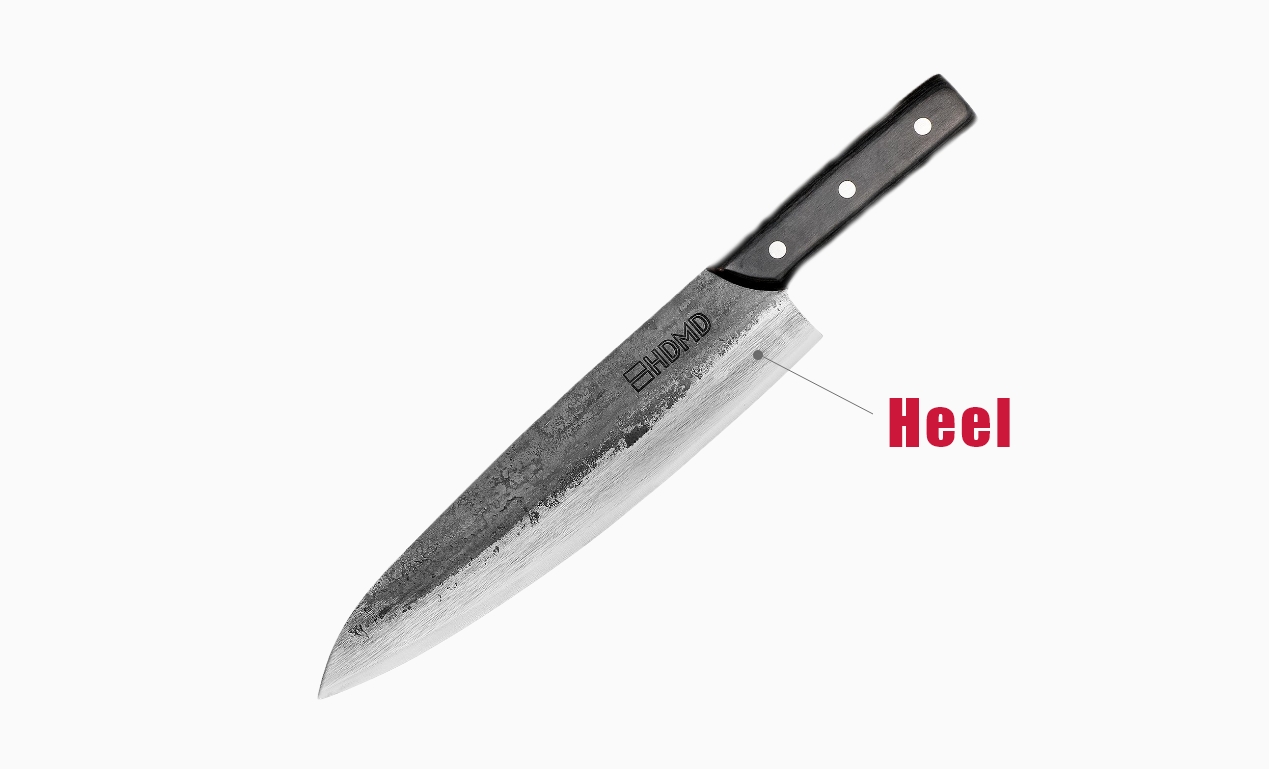
The heel is the widest part of the blade. It is nearest to the handle (with the exception of Japanese-style chef’s knives). Oftentimes, the bigger the knife, the wider the heel is.
Since it is nearest to where you hold the knife, you have the most control over the heel. It is usually used to cut food that needs extra force such as hard vegetables like carrots or even stubborn bones or cartilages.
Knife bolster
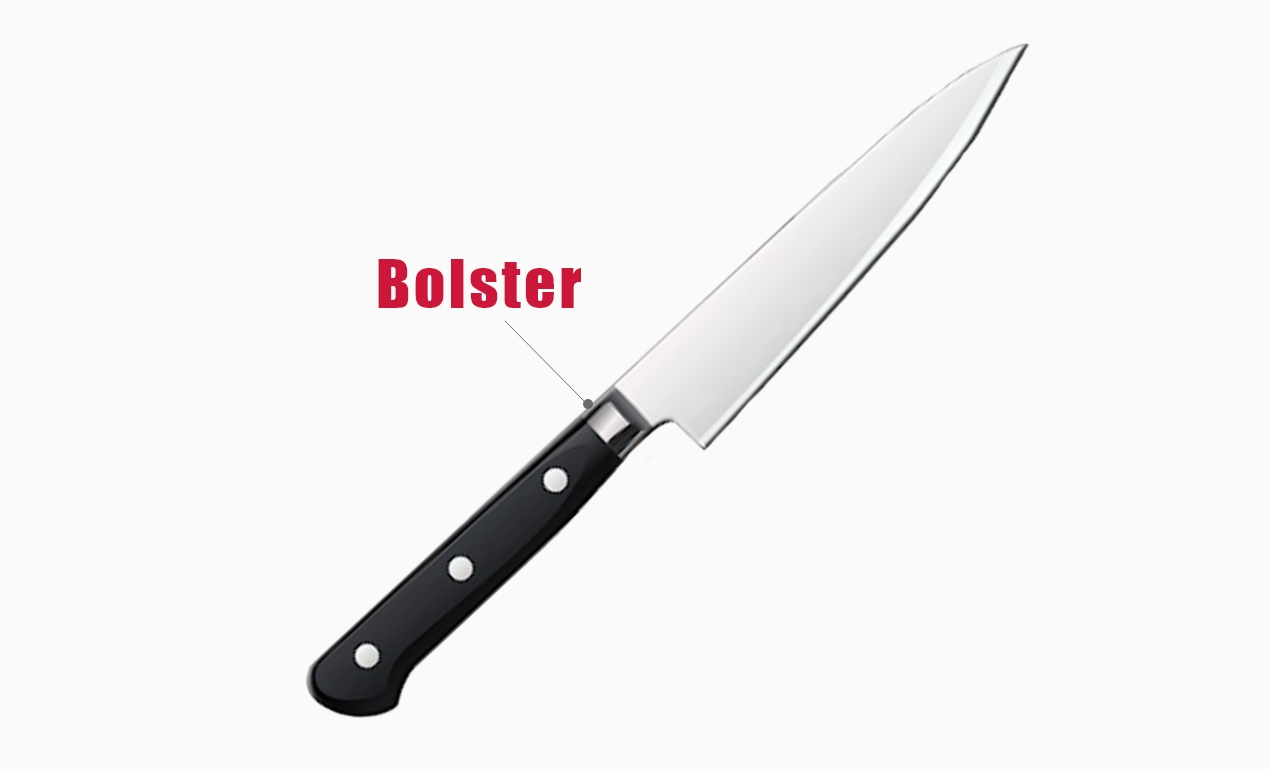
The knife bolster is a blunt, thicker part of the blade. It is placed between the heel and the handle. It serves as a transition from the handle to the exposed parts of the blade.
The purpose of a bolster is to maintain balance and give extra support for your grip. It also helps prevent your finger from sliding to the heel and protects your knife when fileting.
There are knives with full bolsters and semi bolsters. With full bolsters, you get thicker steel extending to the heel. However, this makes it harder to sharpen the blade. Semi bolsters eliminate that problem.
Choosing a knife with or without the bolster ultimately depends on your preference. Some chefs choose knives with bolsters due to aesthetics alone. Some choose it for the design, as they have gotten used to the style and grip. Regardless, both knives will work just fine in the kitchen.
What Is Bolster and Should I Have It on My Chef’s Knife?
Knife handle
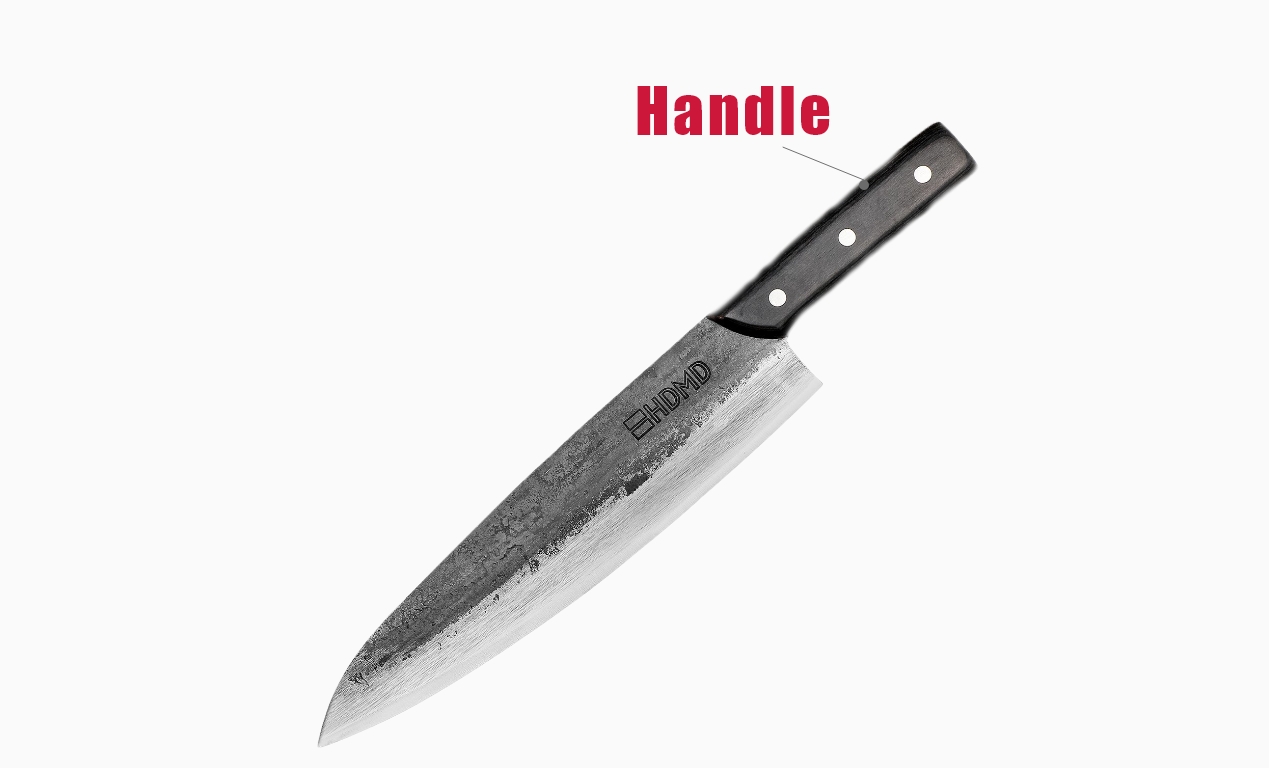
The handle is where you grip your kitchen knife. It covers the tang of your knife and helps you use your knife more conveniently. A kitchen knife with a comfortable handle helps you cut with more ease and efficiency.
We recommend you try how the grip feels before buying your knife. Straight handles are more common but there are also handles with finger grooves.
Kitchen Knife Handle: Why Is It Important?
A handle can be a single molded material where the blade is inserted. It can also be two separate pieces attached to the tang with handle fasteners. These two pieces are called scales. Scales are often made of synthetic or wood material.
Handles are usually made of wood, plastic, rubber, leather, or polymers. In some Japanese knives, the tang serves as the handle itself.
Knife Handle Materials: Which One Should You Choose?
Knife tang
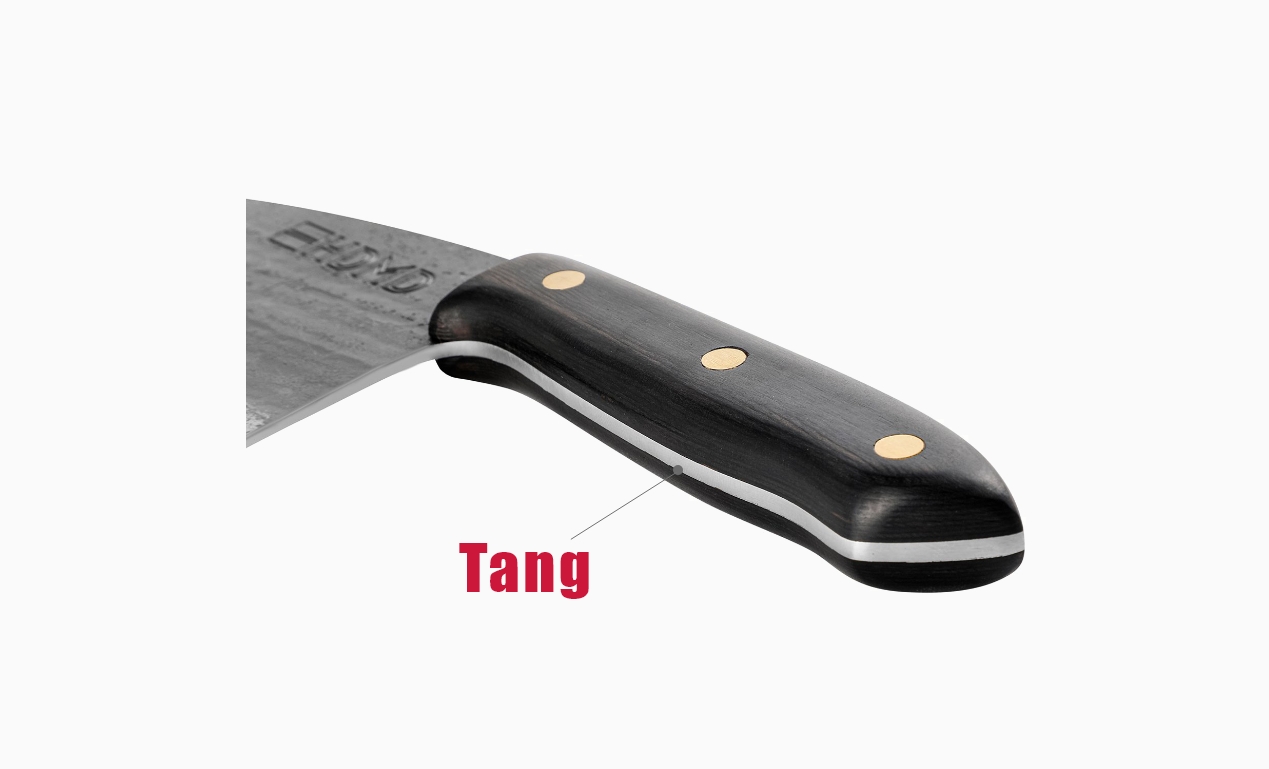
The tang is the part of the blade that is clamped or inserted into the handle. For knives with scales as handles, you will see a stripe of the blade at the middle of the handle.
Generally, a knife can have a full or a partial tang. A kitchen knife with a full tang has the blade extending throughout the handle. Partial tangs, on the other hand, only extend to a portion of the length of the handle.
With full-tang knives, the handle is usually made up of two pieces that are fastened on the sides of the tang using metallic rivets or screws. The handles of each side are called scales.
Partial-tang knives have different lengths and styles. Some types of partial-tangs are rat-tailed tangs, push tangs or tapered tangs. Since the blade material does not extend fully into the handle, it is considered not as durable as full-tang knives. However, these kinds of knives are cheaper because of the lesser amount of metal used for the tang.
A Comprehensive Guide to Knife Tang Types
Handle fasteners
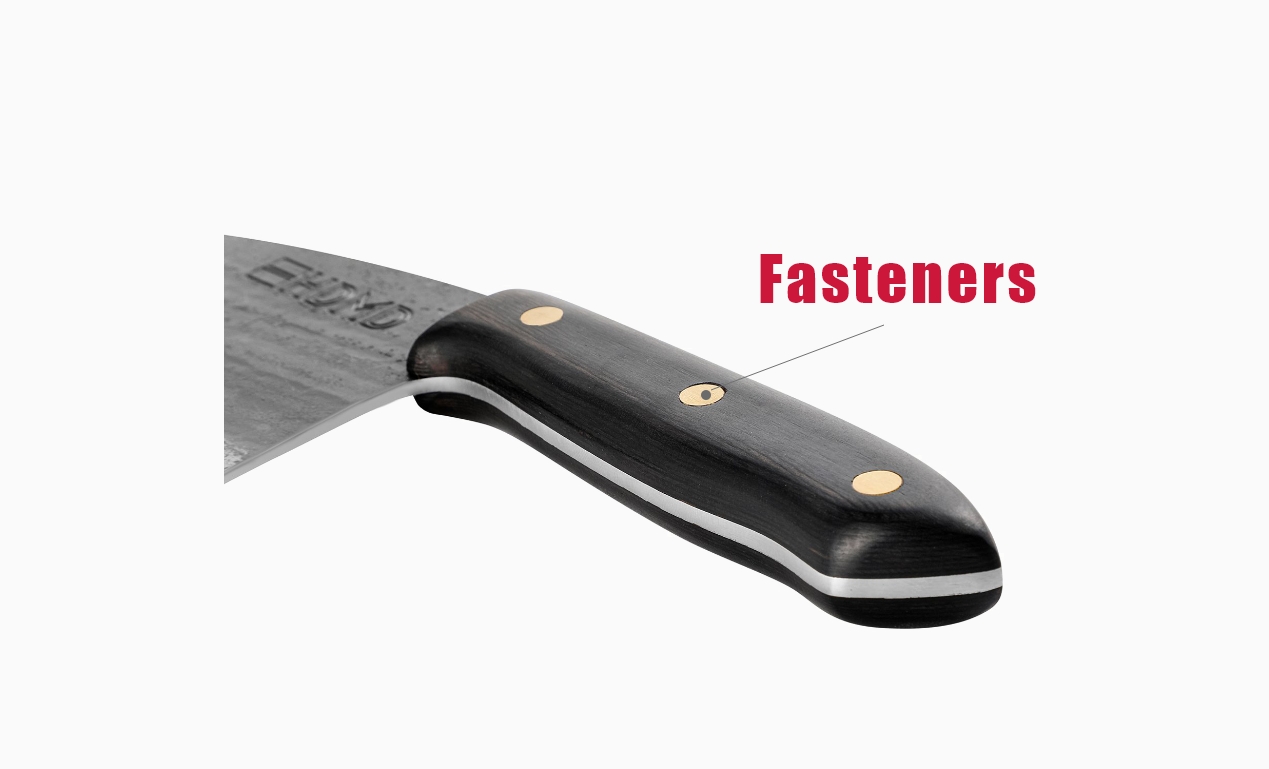
Handle fasteners hold or attach the handle to the tang. There are two common types of handle fasteners: screws and rivets.
Rivets are more commonly used because they are low-maintenance and cost-effective. One downside of rivets is that they are very difficult to remove. It is actually an advantage until you have to change your handle.
Meanwhile, screws are easier to remove for cleaning or replacement of scales. This makes them easier than rivets to loosen up as you use your knife more.
Knife butt
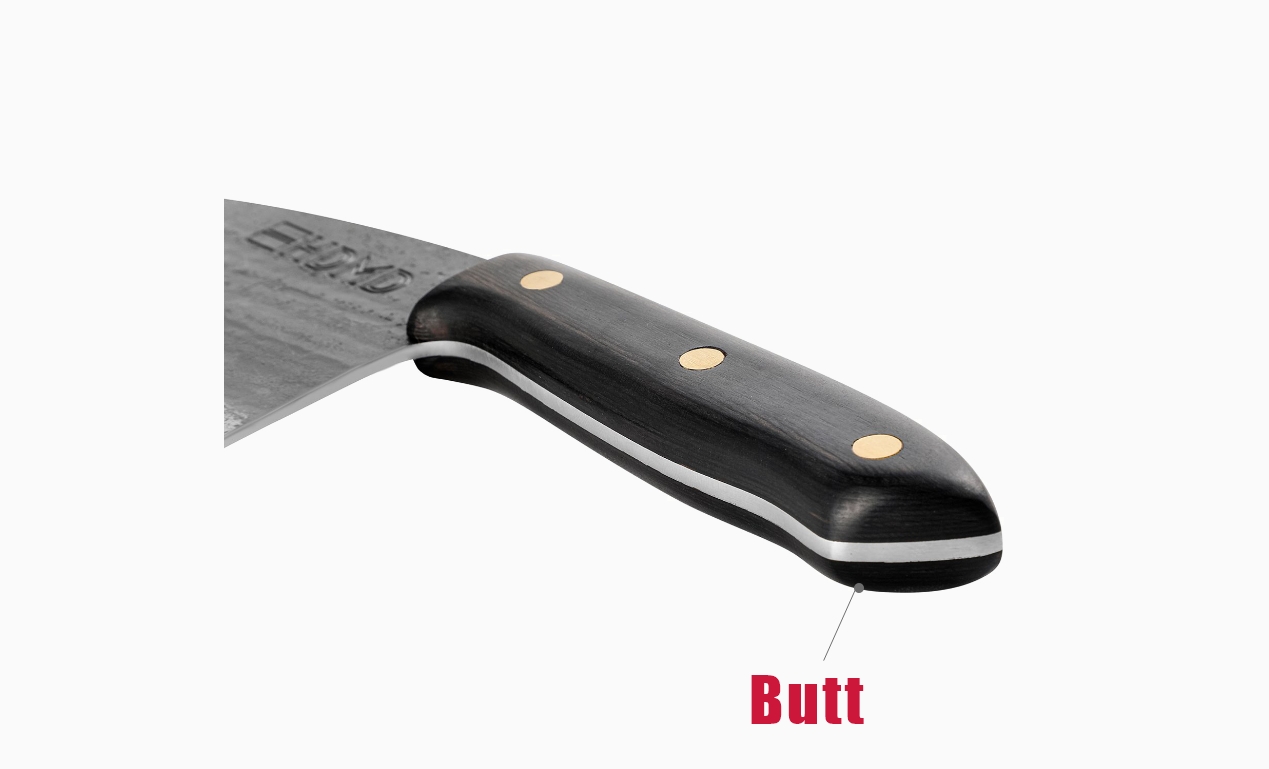
The butt, also known as a pommel, is the very end of the handle. It is usually curved towards the sharpened edge of the knife as a hint for the user. You can sometimes see the end of the tang exposed on the pommel.
Handpicked for you
True cutting power in the palm of your hand
Knife steel
From high carbon to stainless, not to mention the ever popular Damascus steel. A knife won’t be compete without introducing this primary element.
Knife steel can be roughly categorized into two types based on their chemical composition. With more than 13% of chromium content, the steel is classified as stainless. Stainless steel are generally known to be tougher, and hold well against rust. On the other hand, steel that contains more than 0.6% of carbon are known to be sharper, and can retain an edge well.
What Is the Best Steel for Kitchen Knives?
Tips to consider when choosing your kitchen knife
Yes, we know you are excited to get your new kitchen knife. But, unless you are an expert at knives, you should be careful while ordering it.
There are a lot of factors to take into consideration when choosing a new knife — how easy it is to handle, how well it can be sharpened, how lightweight it is, and so on. These tips can help you choose the kitchen knife that will best fit your needs:
- Different knife edges have specific purposes. We recommend that you choose according to what you will use it for. For example, V-Edge knives are basic edges that can be used to cut all the common vegetables, fruits, and meats. Flat ground knives are for heavy-duty uses.
- Full tang knives are more durable. Having rivets holding the scales together is a plus.
- Forged knives, the ones made by heating metal to be reshaped or molded, are generally sturdier than stamped knives.
- Different people are comfortable with different weights of knives. We recommend that you try out several knives to know what is ideal for you.
- Sharpening your knife is one of the most basic ways of taking care of your knife. The higher quality knives need more delicate maintenance to last longer.
Your perfect kitchen knife
Knife preference is very subjective and according to your personal needs. No matter what you choose, the perfect knife is the one that will help you have a more convenient experience.
Whether you want handmade or basic knives, knowing the different parts of a knife is an advantage. It opens you to more choices and helps you make an informed decision.
HDMD Knives combines the passion of forging the best quality with customer satisfaction. Visit our selection of high-quality knives today.












